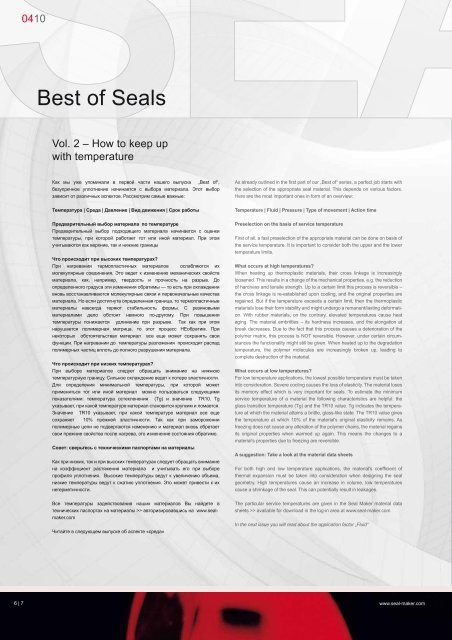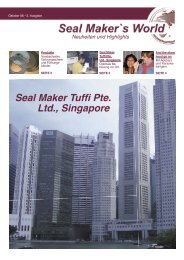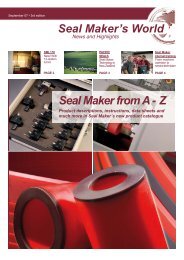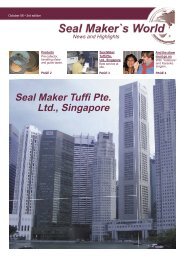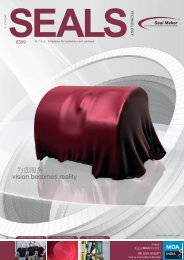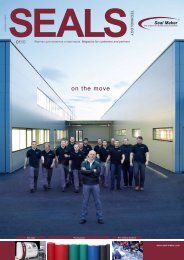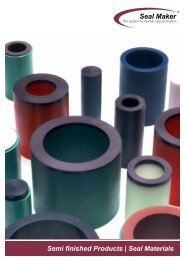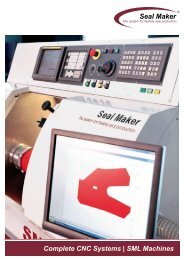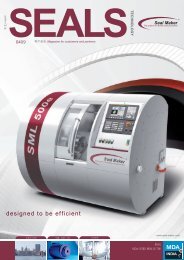TIP - SEAL MAKER
TIP - SEAL MAKER
TIP - SEAL MAKER
You also want an ePaper? Increase the reach of your titles
YUMPU automatically turns print PDFs into web optimized ePapers that Google loves.
0410<br />
Best of Seals<br />
Vol. 2 – How to keep up<br />
with temperature<br />
Как мы уже упоминали в первой части нашего выпуска „Best of“,<br />
безупречное уплотнение начинается с выбора материала. Этот выбор<br />
зависит от различных аспектов. Рассмотрим самые важные:<br />
Температура | Среда | Давление | Вид движения | Срок работы<br />
Предварительный выбор материала по температуре<br />
Предварительный выбор подходящего материала начинается с оценки<br />
температуры, при которой работает тот или иной материал. При этом<br />
учитываются как верхние, так и нижние границы<br />
Что происходит при высоких температурах?<br />
При нагревании термопластичных материалов ослабляются их<br />
молекулярные соединения. Это ведет к изменению механических свойств<br />
материала, как, например, твердость и прочность на разрыв. До<br />
определенного градуса эти изменения обратимы — то есть при охлаждении<br />
вновь восстанавливаются молекулярные связи и первоначальные качества<br />
материала. Но если достигнута определенная граница, то термопластичные<br />
материалы навсегда теряют стабильность формы. С резиновыми<br />
материалами дело обстоит немного по-другому. При повышении<br />
температуры понижается удлинение при разрыве. Так как при этом<br />
нарушается полимерная матрица, то этот процесс НЕобратим. При<br />
некоторых обстоятельствах материал все еще может сохранять свои<br />
функции. При нагревании до температуры разложения происходит распад<br />
полимерных частиц вплоть до полного разрушения материала.<br />
Что происходит при низких температурах?<br />
При выборе материалов следует обращать внимание на нижнюю<br />
температурную границу. Сильное охлаждение ведет к потере эластичности.<br />
Для определения минимальной температуры, при которой может<br />
применяться тот или иной материал можно пользоваться следующими<br />
показателями: температура остекленения (Tg) и значение TR10. Tg<br />
указывает, при какой температуре материал становится хрупким и ломается.<br />
Значение TR10 указывает, при какой температуре материал все еще<br />
сохраняет 10% прежней эластичности. Так как при заморожении<br />
полимерные цепи не подвергаются изменению и материал вновь обретает<br />
свои прежние свойства после нагрева, это изменение состояния обратимо.<br />
Совет: сверьтесь с техническими паспортами на материалы<br />
Как при низких, так и при высоких температурах следует обращать внимание<br />
на коэффициент растяжения материала и учитывать его при выборе<br />
профиля уплотнения. Высокие температуры ведут к увеличению объема,<br />
низкие температуры ведут к сжатию уплотнения. Это может привести к их<br />
негерметичности.<br />
Все температуры задействования наших материалов Вы найдете в<br />
технических паспортах на материалы >> авторизировавшись на www.sealmaker.com<br />
Читайте в следующем выпуске об аспекте «среда»<br />
As already outlined in the first part of our „Best of“ series, a perfect job starts with<br />
the selection of the appropriate seal material. This depends on various factors.<br />
Here are the most important ones in form of an overview:<br />
Temperature | Fluid | Pressure | Type of movement | Action time<br />
Preselection on the basis of service temperature<br />
First of all, a fast preselection of the appropriate material can be done on basis of<br />
the service temperature. It is important to consider both the upper and the lower<br />
temperature limits.<br />
What occurs at high temperatures?<br />
When heating up thermoplastic materials, their cross linkage is increasingly<br />
loosened. This results in a change of the mechanical properties, e.g. the reduction<br />
of hardness and tensile strength. Up to a certain limit this process is reversible –<br />
the cross linkage is re-established upon cooling, and the original properties are<br />
regained. But if the temperature exceeds a certain limit, then the thermoplastic<br />
materials lose their form stability and might undergo a remanent/lasting deformation.<br />
With rubber materials, on the contrary, elevated temperatures cause heat<br />
aging. The material embrittles – its hardness increases, and the elongation at<br />
break decreases. Due to the fact that this process causes a deterioration of the<br />
polymer matrix, this process is NOT reversible. However, under certain circumstances<br />
the functionality might still be given. When heated up to the degradation<br />
temperature, the polymer molecules are increasingly broken up, leading to<br />
complete destruction of the material.<br />
What occurs at low temperatures?<br />
For low temperature applications, the lowest possible temperature must be taken<br />
into consideration. Severe cooling causes the loss of elasticity. The material loses<br />
its memory effect which is very important for seals. To estimate the minimum<br />
service temperature of a material the following characteristics are helpful: the<br />
glass transition temperature (Tg) and the TR10 value. Tg indicates the temperature<br />
at which the material attains a brittle, glass-like state. The TR10 value gives<br />
the temperature at which 10% of the material's original elasticity remains. As<br />
freezing does not cause any alteration of the polymer chains, the material regains<br />
its original properties when warmed up again. This means the changes to a<br />
material's properties due to freezing are reversible.<br />
A suggestion: Take a look at the material data sheets<br />
For both high and low temperature applications, the material's coefficient of<br />
thermal expansion must be taken into consideration when designing the seal<br />
geometry. High temperatures cause an increase in volume, low temperatures<br />
cause a shrinkage of the seal. This can potentially result in leakages.<br />
The particular service temperatures are given in the Seal Maker material data<br />
sheets >> available for download in the log-in area at www.seal-maker.com<br />
In the next issue you will read about the application factor „Fluid“<br />
6 | 7 www.seal-maker.com


